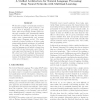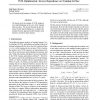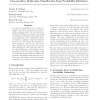105
Voted
ICML
2008
IEEE
16 years 1 months ago
2008
IEEE
Most existing sparse Gaussian process (g.p.) models seek computational advantages by basing their computations on a set of m basis functions that are the covariance function of th...
125
click to vote
ICML
2008
IEEE
2008
IEEE
A unified architecture for natural language processing: deep neural networks with multitask learning
16 years 1 months ago
We describe a single convolutional neural network architecture that, given a sentence, outputs a host of language processing predictions: part-of-speech tags, chunks, named entity...
88
Voted
ICML
2008
IEEE
16 years 1 months ago
2008
IEEE
This paper aims to conduct a study on the listwise approach to learning to rank. The listwise approach learns a ranking function by taking individual lists as instances and minimi...
107
click to vote
ICML
2008
IEEE
16 years 1 months ago
2008
IEEE
A new algorithm for training Restricted Boltzmann Machines is introduced. The algorithm, named Persistent Contrastive Divergence, is different from the standard Contrastive Diverg...
ICML
2008
IEEE
16 years 1 months ago
2008
IEEE
We present an active learning scheme that exploits cluster structure in data.
ICML
2008
IEEE
16 years 1 months ago
2008
IEEE
We discuss how the runtime of SVM optimization should decrease as the size of the training data increases. We present theoretical and empirical results demonstrating how a simple ...
ICML
2008
IEEE
16 years 1 months ago
2008
IEEE
In one-class classification we seek a rule to find a coherent subset of instances similar to a few positive examples in a large pool of instances. The problem can be formulated an...
92
Voted
ICML
2008
IEEE
16 years 1 months ago
2008
IEEE
For two-class classification, it is common to classify by setting a threshold on class probability estimates, where the threshold is determined by ROC curve analysis. An analog fo...
93
Voted
ICML
2008
IEEE
16 years 1 months ago
2008
IEEE
The problem of obtaining the maximum a posteriori (map) estimate of a discrete random field is of fundamental importance in many areas of Computer Science. In this work, we build ...




